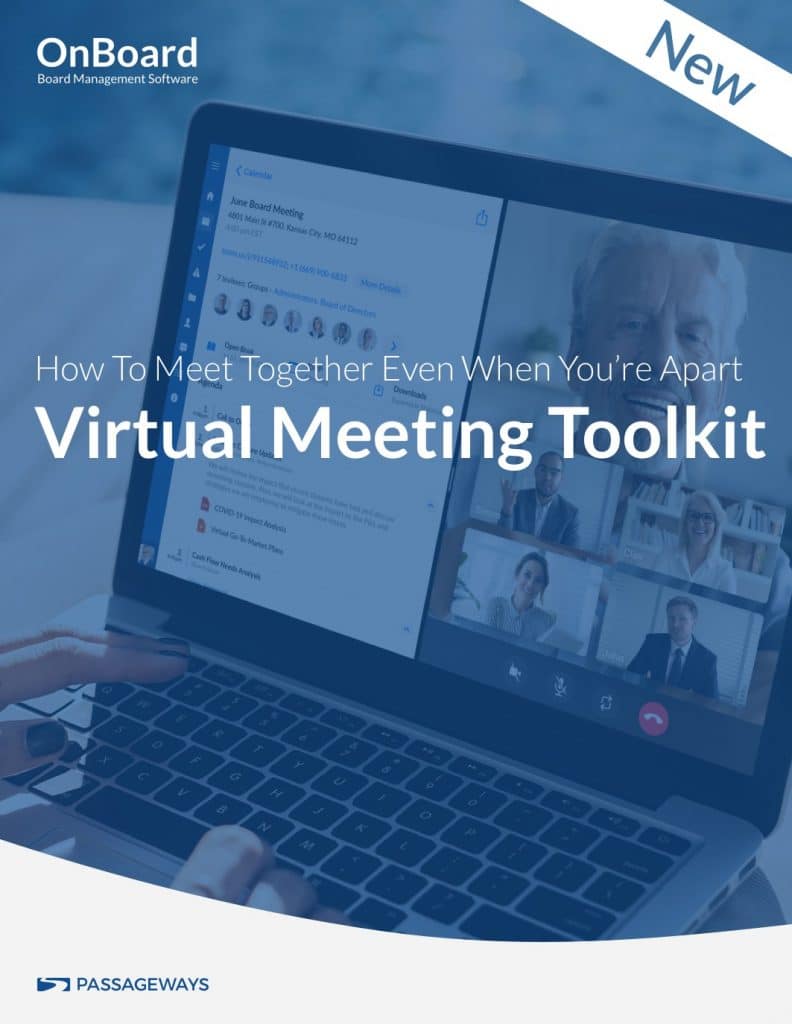
The COVID-19 crisis created an unprecedented situation where virtual meetings and remote work replaced physical, in-person interactions in nearly every organization across all industries, demographics, and regions. Overnight.
It’s also true that while COVID-19 was the catalyst for switching to virtual meetings, the shift from in-person, physical meetings had already begun some time ago. Indeed, 7.7% of the Russell 3000 (an index of the 3000 largest U.S.-traded public companies) since 2014 had already started holding their annual shareholder meetings virtually.
An Expert Panel Shares Real Insight about What’s Actually Happening
On paper, moving from in-person to virtual meetings sounds trivial. In actual practice, it is anything but. For effective and productive virtual board meetings, directors must be better prepared, more highly organized, and engage more collaboratively than they would for in-person meetings.
Passageways recently convened an expert panel of admins, executive leaders, and board directors working on the frontlines in various industries, demographics, and regions. We asked them to tell us about their observations from moving to virtual meetings and are proud to share them here.
3 Observations on What It’s Really Like to Shift to Virtual Meetings
- Most organizations made the shift easily and also experienced cost savings.
- Board admins or IT teams handle training for virtual meetings.
- It is challenging to keep virtual meeting attendees fully engaged.
Our expert panel elaborated further, and their insights are provided below. Remember, this is not abstract or hypothetical ideas about what might be. It is real, honest feedback based on what organizations are actually going through as they’ve transitioned to virtual board meetings.
Full disclosure: all of the individuals quoted here are customers of our OnBoard virtual board management software. They received no compensation for their feedback.
Observation 1
Most organizations made the shift easily
and also experienced cost savings.
Historically, massive change has often taken place with little to no warning. How an organization reacts depends on a multitude of factors, including its mission, the composition of the board, and the culture.
Jennie Krejci, Senior Manager, Administration for RHR International, reported that her organization’s board transitioned smoothly.
“[Board members] have adapted quite well. We used the portal for the first time in December. For our March meeting, only one member asked for a quick refresher, which took about five minutes.”
Anna Carpenter, Communications & Membership Coordinator for the Association of Genuine Alaska Pollock Producers, noted the frustration of some board members and how it was essential to have resources and help standing by.
“Our board members have had to make a quick shift to virtual meetings because of COVID-19. While it’s been relatively frustrating adjustment for some of them, most have made the transition with no problems at all. They’ve found that the most helpful thing you can do is serve as a resource when they have questions.”
As every organization looks to make changes for the long-term, it’s important to maintain the norms that work best for its members. Amy Atkinson, Executive Assistant at Middle Tennessee Electric Membership Corporation (MTEMC), shared a sentiment that many organizations will no doubt have to consider in a post-quarantine world.
“They’ve adjusted fairly well. Our board has always done well in person, so it will be interesting to see how virtual meetings balance out with physically getting together in the future.
Shifting to virtual meetings also enables organizations to eliminate costs that are inherent to physical, in-person meetings.
Jean Mina, the Administrative Director in the Office of the President at Rosalind Franklin University of Medicine and Science, listed all the costs her organization saved by having a virtual board meeting.
“Air transportation, hotel guest rooms, food for the board dinner and board lunch, and room rentals at the hotel for committee meetings.”
Clarissa Schneider, Executive Secretary at Northwestern Rural Electric Cooperative Association, pointed to similar savings her organization experienced.
“March was the first board meeting that Northwestern REC held completely remotely. As a result, there were small yet direct cost savings to the cooperative. For example, food was not provided, whereas if the meeting were onsite, breakfast would have been an additional, yet minimal expense.”
Brayden Connour, Business Development Director for the Goshen County Economic Development Corporation, pointed to savings in paper as a critical benefit to virtual meetings.
“Whether it is our yearly budget or the month to month deposits and spending, [shifting to virtual meetings] has saved us a ton of paper. I guarantee the paper savings has made an impact already.”
Observation 2
Board admins or IT teams handle
training for virtual meetings.
With the shift to virtual meetings taking place practically overnight, organizations have had to decide quickly on what kind of special training to make available to its directors. Most have either done without or had it handled by board admins or IT teams.
Belinda Diefenbach, Senior Vice President, Administrative Associate, and Corporate Secretary for Susquehanna Community Bank, turned to IT after COVID-19 necessitated virtual meetings at her organization.
“Our IT person set us up on Zoom. There wasn’t time for detailed training, but we are able to function very well even without it.”
A spirit of DIY also prevails throughout many organizations. Sandy Klatt, Executive Assistant and Corporate Secretary for Forward Bank, took note that many of her board members had experience already with Zoom.
“A handful of people had already used Zoom before, so I sent out a reminder on how it works.”
Jean Mina, the Administrative Director in the Office of the President at Rosalind Franklin University of Medicine and Science, had already been handling training for her board before the onset of COVID-19.
“I’ve been doing a lot of hands-on, one-on-one training with my team by myself since July 2019.”
Observation 3
It is challenging to keep virtual meeting attendees fully engaged.
Keeping attendees engaged and holding their attention is difficult in virtual meetings. This is nobody’s “fault.” Indeed, it is natural and to be expected. There is a different ebb and flow to a virtual meeting vis-à-vis an in-person meeting. With a lack of in-person presentation and discussion, more focus is required from attendees to follow and participate. This gradually saps attention spans, exhausts attendees, and can create physical soreness and discomfort.
Christy Batien Clark, Executive Director for Ronald McDonald House Charities of Siouxland, shared a difficulty common with many virtual board meetings.
“The majority of our board members signed on to the last meeting with audio-only. If they didn’t speak, I had no idea if they were paying attention.”
Sandy Klatt, Executive Assistant and Corporate Secretary for Forward Bank, recognized that the need to keep attendees engaged was something they had been already experienced when their meetings were a hybrid (i.e., both virtual and in-person).
“If they weren’t in person, we used Zoom to video conference with them and always shared screens. Asking for feedback from attendees not in person was always a must so their opinion was spoken.”
Jean Mina, the Administrative Director in the Office of the President at Rosalind Franklin University of Medicine and Science, also noted that prior experience with virtual board meetings gave her the impetus to plan additional actions to keep attendees engaged.
“I create a more detailed agenda list for our board chair with notes on important items (i.e., a roll call vote while in a conference call). That helps the chair keep the trustees involved and engaged.”
Anna Carpenter, Communications & Membership Coordinator for the Association of Genuine Alaska Pollock Producers, drew the others’ envy with her comment.
“Our board tends to stay engaged and focused on their own. Luckily, they take these meetings pretty seriously – and they like an early end time!”
Tips and best practices for what makes a great virtual board meeting.
With so many making the shift to virtual board meetings for the first time, there is a great deal of trial and error taking place. Fortunately, nearly everyone is ready to share their tips and best practices for what makes a great virtual board meeting.
Here is a list of the top tips and recommendations for holding a great virtual board meeting:
- Use video and encourage people to turn on their cameras. The more people on video, the better! It’s easier to talk when you can see people’s faces.
- Don’t wait until the last minute to distribute your board materials. Ideally, they should be distributed as long as possible before your virtual meeting.
- Have all of your procedures easily available for logging in or requesting tech support for board members to refer to.
- Ask pointed questions before moving onto the next agenda item like “How will this decision affect our key stakeholders?” or “What are some of the reasons people will disagree with this decision?”
- Ping people in private on instant messenger during the meeting to check in, especially if they’ve been very quiet.
The Last Word
The last word goes to Anna Carpenter, Communications & Membership Coordinator for the Association of Genuine Alaska Pollock Producers.
“Flexibility and a willingness to learn are imperative! There’s no need to take ourselves too seriously, either. We’re all learning and adjusting together. Mistakes might happen, but we’ll figure it out eventually. When all else fails, ask for help.”

Download the Virtual Meeting Toolkit
Introducing the definitive guide to conducting effective and productive virtual meetings.
About The Author

- At OnBoard, we believe board meetings should be informed, effective, and uncomplicated. That’s why we give boards and leadership teams an elegant solution that simplifies governance. With customers in higher education, nonprofit, health care systems, government, and corporate enterprise business, OnBoard is the leading board management provider.
Latest entries
 Board Management SoftwareJuly 26, 20225 Critical Board Engagement Survey Questions
Board Management SoftwareJuly 26, 20225 Critical Board Engagement Survey Questions Board Management SoftwareJuly 19, 2022What is an Advisory Council? (Overview, Roles, and Responsibilities)
Board Management SoftwareJuly 19, 2022What is an Advisory Council? (Overview, Roles, and Responsibilities) Board Management SoftwareJuly 15, 2022Balance Sheet vs. Income Statement: What’s the Difference?
Board Management SoftwareJuly 15, 2022Balance Sheet vs. Income Statement: What’s the Difference? Board Management SoftwareJuly 12, 2022Sweat Equity: Mark Haas of the Dallas Cup Board Gives a Nonprofit Play-by-Play for Success
Board Management SoftwareJuly 12, 2022Sweat Equity: Mark Haas of the Dallas Cup Board Gives a Nonprofit Play-by-Play for Success
